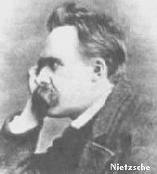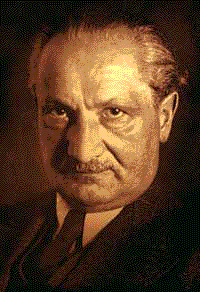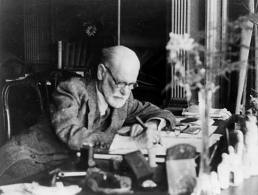Existentialist thought – A Departure from Descartes
Jean-Paul Sartre (1905 – 1980)
 include a rejection of Descartes; now the self is thought of as being whole, equivalent with the body, not divided into two (Descartes) or three (Freud) parts. Our existence is defined as not simply being but rather, ‘being in the world’. There is a tendency to emphasise the necessity of the emotions (anguish, despair, anxiety etc.,) as part of the human experience. In addition, existential philosophies all share a common thread in their purpose of project; they are all borne through a reaction against particular paradigms that exclude or marginalise the questions about what it means to be human. These reactions might be against bourgeois “mauvais fois” (bad faith, or self deception), the Victorian ethic or perhaps more radically, against the whole of philosophy. Heidegger believed that all of philosophy had in effect skipped over the question of what it means to ‘be there’. In general, the conclusion drawn is that there is something important about our feelings, emotions and consciousness of consciousness that has been forgotten about by the rest of philosophy. The binding ingredient of existentialism is ultimately subjectivity, and this brings the philosophy into conflict with objective pursuits of knowledge.
include a rejection of Descartes; now the self is thought of as being whole, equivalent with the body, not divided into two (Descartes) or three (Freud) parts. Our existence is defined as not simply being but rather, ‘being in the world’. There is a tendency to emphasise the necessity of the emotions (anguish, despair, anxiety etc.,) as part of the human experience. In addition, existential philosophies all share a common thread in their purpose of project; they are all borne through a reaction against particular paradigms that exclude or marginalise the questions about what it means to be human. These reactions might be against bourgeois “mauvais fois” (bad faith, or self deception), the Victorian ethic or perhaps more radically, against the whole of philosophy. Heidegger believed that all of philosophy had in effect skipped over the question of what it means to ‘be there’. In general, the conclusion drawn is that there is something important about our feelings, emotions and consciousness of consciousness that has been forgotten about by the rest of philosophy. The binding ingredient of existentialism is ultimately subjectivity, and this brings the philosophy into conflict with objective pursuits of knowledge.
The body – Friedrich Nietzshe (1844 – 1900)

For Nietzsche, body and self are one and the same, “Behind thy thoughts and feelings, my brother, stands a mighty lord, an unknown wiseman- whose name is self. In the body he dwelleth, thy body he is.” Here, Nietzsche claims that the self is not separate from but equivalent with the body.
Beings in the world – Heidegger (1889 – 1976)
Our existence is defined as being in the world; we are Beings-in-the-world. This hyphenation, which is found in existential writings, places emphasis on the relationship between the world and the individual. While we certainly have relationships with the objects in the world we also, perhaps more importantly, have relationships with other Beings, or ‘Dasein’ (to be there) to use Heideggerian terminology.
Emotions
Emotional experiences precede the essence of man and make him what he is (this is his essence). Furthermore, they are necessary for us to become truly or authentically human.
Ontological Insecurity – R D Laing (1927 – 1989)
 In his book, ‘The Divided Self’ R.D. Laing addresses problems of embodiment from an existential perspective. His basic idea is that patients (particularly schizoids and schizophrenics) suffer from ‘ontological insecurity’. Here, ‘ontological’ is used as an adjective derived from ‘being’. He suggests that patients displaying disembodiment have suffered a fracturing of the Self due to two main causes. Firstly, it is possible that a genetic disposition towards inactivity, or exploration of the world by oneself contributes towards insecurity of Being. Secondly, Laing proposes that an over-protective caregivermother, who smothers the child, prevents the child from consolidating her Being. The two factors exacerbate each other and lead to schizoid or schizophrenic behaviour. According to Laing the insecurity of one’s Being leads to certain anxieties, of which he identifies three types: engulfment, implosion, petrification and depersonalisation.
In his book, ‘The Divided Self’ R.D. Laing addresses problems of embodiment from an existential perspective. His basic idea is that patients (particularly schizoids and schizophrenics) suffer from ‘ontological insecurity’. Here, ‘ontological’ is used as an adjective derived from ‘being’. He suggests that patients displaying disembodiment have suffered a fracturing of the Self due to two main causes. Firstly, it is possible that a genetic disposition towards inactivity, or exploration of the world by oneself contributes towards insecurity of Being. Secondly, Laing proposes that an over-protective caregivermother, who smothers the child, prevents the child from consolidating her Being. The two factors exacerbate each other and lead to schizoid or schizophrenic behaviour. According to Laing the insecurity of one’s Being leads to certain anxieties, of which he identifies three types: engulfment, implosion, petrification and depersonalisation.
Engulfment
Engulfment is characterised by a fear of being literally swamped by other people, enveloped by their Being, and therefore, of dying. Obviously, this does not mean dying in the physical or legal sense, but a fear of being existentially dead. As shall become apparent the body becomes separated from the Self and becomes irrelevant to the inner Self.
Implosion
Implosion is an anxiety generated by an emptiness that is felt as a result of ontological insecurity. As the person feels more and more empty, like a void or a vacuum, the more this fear that the world will rush into the vacuum that is the Self and destroy it.
Petrification and Depersonalisation
Petrification, as the name suggests, refers to the fear of being turned, or turning others to stone. That is, the terror of being objectified, made into a machine, an automaton. Depersonalisation is a general term used to denote a refusal to acknowledge the Being of others and in turn to deny one’s own Being.
Laing suggests that as ontological insecurity grows, the patient draws himself inwards towards an inner ‘citadel’ at the expense of everything other than his inner, or core self. This includes his other selves, or ‘false-self system’ and his body. In an attempt to avoid being killed, the individual, existentially, kills himself. This paradox is at the heart of Laing’s work in “The Divided Self”. Anxiety causes the patient to flee from the world and become un-real in order to prevent others from making him un-real. However, the person still wants to be alive and strives to make a connection with the world. This turns out to be very difficult in the face of the onslaught of anxiety that springs from ontological insecurity. Thus we have a position where patients feel that they are not real, where they are not flesh and blood but machines. Laing gives the example of a schizoid who, upon being attacked in an alley, finds the whole situation rather pointless, meaningless. His objection is that the protagonists can hardly hope to gain anything, as he has no money, and they surely cannot hurt him because he is not his body, his inner self has divorced itself from the body and from other Beings around him.
Although Sigmund Freud was not a philosopher, his theories and writings amounted to a  philosophy of the nature of human beings and have had an enormous impact on western culture. His theories are of particular relevance to emotional processing; he developed the Aristotelian concept of catharsis to a much greater degree, closely linking it to another major concept, repression. Catharsis was regarded as a method of bringing repressed ideas or experiences to consciousness so that underlying tensions may be relieved. Freud developed psychoanalysis, the first type of ‘talking cure’. It formed the template for all the major methods of psychological therapy which developed over the 20th century. The many shades of Psychoanalysis, Rogerian Client Centred therapy, Gestalt therapy, Transactional Analysis and many other approaches, have different nuances of theory and interpretation. However, all share the element of helping the patient to talk about, express and explore their problems and conflicts and benefit through the talking. Whilst there are different understandings of how therapy might operate, often a cathartic idea is implied – distressing elements which the patient did not understand are expressed are ‘worked through’ to the point where the patient feels more at ease and makes sense of their problem.
philosophy of the nature of human beings and have had an enormous impact on western culture. His theories are of particular relevance to emotional processing; he developed the Aristotelian concept of catharsis to a much greater degree, closely linking it to another major concept, repression. Catharsis was regarded as a method of bringing repressed ideas or experiences to consciousness so that underlying tensions may be relieved. Freud developed psychoanalysis, the first type of ‘talking cure’. It formed the template for all the major methods of psychological therapy which developed over the 20th century. The many shades of Psychoanalysis, Rogerian Client Centred therapy, Gestalt therapy, Transactional Analysis and many other approaches, have different nuances of theory and interpretation. However, all share the element of helping the patient to talk about, express and explore their problems and conflicts and benefit through the talking. Whilst there are different understandings of how therapy might operate, often a cathartic idea is implied – distressing elements which the patient did not understand are expressed are ‘worked through’ to the point where the patient feels more at ease and makes sense of their problem.
Brener (1957) suggests that Freud’s view of repression was a cornerstone of psychoanalysis.
‘Looking back on what he called a simple step (ie positing the existence of repression), one may, as an historian, take the liberty of disputing with Freud’s modest characterisation of this momentous hypothesis since in fact it introduced into psychopathology the fundamental theoretical concept that intrapsychic conflict and its consequences were of essential significance in the formation of neurotic symptoms.’
Freud postulated that energy/force/pressure/power was involved in repressing painful memories or threatening ideas.
‘We may imagine that what is repressed exercises a continuous straining in the direction of consciousness, so that the balance has to be kept by means of a steady counter pressure. A constant expenditure of energy, therefore, is entailed in maintaining a repression.'(Freud …)
Catharsis represents a ‘release’ of this energy, bringing relief and healing. Others have described this (often disparagingly) as a ‘hydraulic theory’, disagreeing that mental energy can work like water pressure. Freud used many metaphors to describe the operation of psychic energy – pressure, balance, energy, force, resistance. He was strongly influenced by Helmholtz’s formulation of the principle of the conservation of energy which states that energy in a physical system is always constant and cannot be changed; as energy changes in one part of the system it inevitably effects other parts of the system. Freud was the first to apply these ideas to the human psyche as a useful metaphor. In his project or Scientific Psychology (1895) he had abandoned the attempt to reduce psychological phenomena to literal physiological processes so he was not suggesting the brain literally works hydraulically. The hydraulic metaphor has been simplified and debased in the media to a folklore belief that if any emotion is ‘bottled up’ the pressure will ruin our health.
Emotional processing, like much of psychotherapy, is influenced by Freud’s notions of repression, catharsis and the blocking and transforming of psychological energy, though it does not rest on a psychoanalytical model.